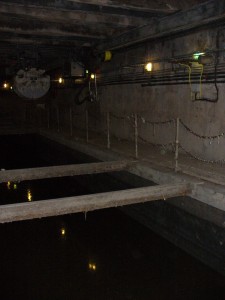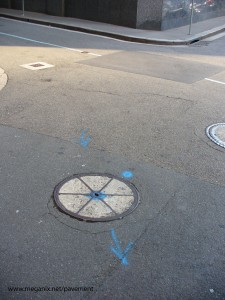
Manhole cover in Avenue Bosquet
I have a certain fondness for manhole covers. They are reminders that the pavement is not only a floor but a roof – the roof of a busy world of tunnels, tubes, chambers and canals; of light, electricity, water and workers. Manhole covers are shutters on the skylights in this roof.
Readers of this blog will know that earlier this year I was lucky enough to do a tour of the underground Tank Stream in Sydney, and to photograph several manhole covers from below. But now I have gone one better – I have toured the sewers of Paris, or at least a small section of them. Parisians are justifiably proud of their sewer network, their ‘city beneath the city’, designed and built in the mid-1800s. So proud that they have a museum – Le Musée des Égouts - where, descending beneath the street of Quai d’Orsay, you can walk through tunnels with drinkable and non-drinkable water flowing through pipes beside you, and a river of sewage running along canals beneath you. In the photograph below on the left you can see the tunnel lights reflected in this river.

Bruneseau Gallery of the Paris Sewer Museum
I tried to find a manhole cover that I could photograph from below but the best I could do was the iron stairway leading up to one. I could not stretch my arm far enough beyond the museum barrier to photograph the cover itself.
Afterwards, when I returned to the fresh air of the street, I walked along Avenue Bosquet and, assuming that I paced the distance out correctly, found the manhole cover I had nearly photographed in the chamber below.

Steps beneath manhole in Avenue Bosquet















 Recently uncovered by Marrickville Council during street plumbing activity under two Camphor Laurel trees on the eastern side of upper Metropolitan Road, Enmore, Sydney, are what appear to be sandstone cobblestones.
Recently uncovered by Marrickville Council during street plumbing activity under two Camphor Laurel trees on the eastern side of upper Metropolitan Road, Enmore, Sydney, are what appear to be sandstone cobblestones. Other views suggest the sandstone course may have been associated either with some early civil works project or may have been laid in conjunction with the arrangement of street tree planting.
Other views suggest the sandstone course may have been associated either with some early civil works project or may have been laid in conjunction with the arrangement of street tree planting.